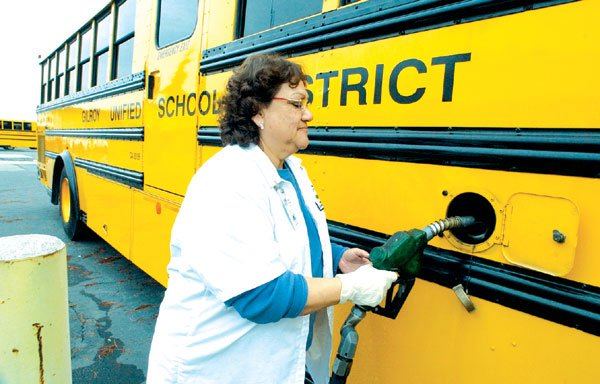Gilroy
– Recent changes in the school district’s transportation
department will save about $600,000 over the next two years.
The most significant department change has been a new district
policy, implemented this year, that says students can ride buses
only to schools within their attendance areas instead of through
different areas of town.
Gilroy – Recent changes in the school district’s transportation department will save about $600,000 over the next two years.
The most significant department change has been a new district policy, implemented this year, that says students can ride buses only to schools within their attendance areas instead of through different areas of town. Before, bus routes were criss-crossing the district and making multiple stops, with some students using buses as their own personal taxi service to get to dance class, a babysitter’s house or wherever else they need to go that is in close proximity to the schools.
Now, only one bus takes students from one area to and from school and the bus stop.
That change alone has saved the district about $207,000 – or the equivalent of 4 1/2 positions, said Darren Salo, GUSD’s transportation supervisor. Because buses aren’t being used as much as before, wear and tear, tire replacement and the need for fuel all have been reduced.
“We’re not having to go everywhere to everywhere, and that does help,” he said.
Additionally, the district this year laid off one service person and one mechanic. The department’s staff now consists of 27 bus drivers, two mechanics, two dispatchers, two trainers and a staff secretary.
Another part of the cost savings comes from lower-than-anticipated fuel costs, for which the department budgeted $3 per gallon, Salo said.
“We did expect the fuel to go higher, and that didn’t happen,” he said. “Fuel has dropped and is staying under the two dollar mark. That’s a savings we didn’t anticipate but have taken this year.”
Currently, fuel is about $1.78 per gallon. Each large bus, holding a maximum 100 gallons, is fueled at one-half tank twice a week. Six of the district’s buses are air-quality buses, which run on ultra low sulfur diesel. That fuel costs five cents per gallon more than regular diesel but emits significantly less pollution. Salo said the district recently applied for a $320,000 grant from the Bay Area Air Quality Management District to purchase two more of those kinds of buses.
The district also recently purchased five buses that it used to lease, which replaced five older and higher polluting buses.
The time students spend riding buses has been dramatically reduced this year, from up to two hours down to as short as 15 minutes, Salo said. A board policy has been in place for several years stating that any single bus ride shouldn’t last more than 60 minutes. But enforcement has been spotty, something Salo said the district has made more of an effort to change this year.
“We’ve pretty much met that goal, except out on Pacheco Pass,” Salo said. “It takes a while to get out there.”
Several years ago, the district purchased and implemented a computer software program intended to help determine the most efficient bus routes. But the program was ineffective and essentially accomplished what district staff could do “using our brains,” Salo said.
Part of the reason the district axed the software program is there simply wasn’t a need. GUSD’s total number of routes, 27, is significantly less than that of many other unified school districts, such as Pajaro Valley, with 118 routes, or Elk Grove, with routes numbering into the 200s.
Salo said GUSD’s current system of mapping routes is adequate.
“We look at where we can double up on routes and be more efficient,” he said, “and it works well.”
Transportation costs
2001-02 $1,582,485
2002-03 $2,300,870
2003-04 $2,493,460
• $600,000 savings over the next two years













